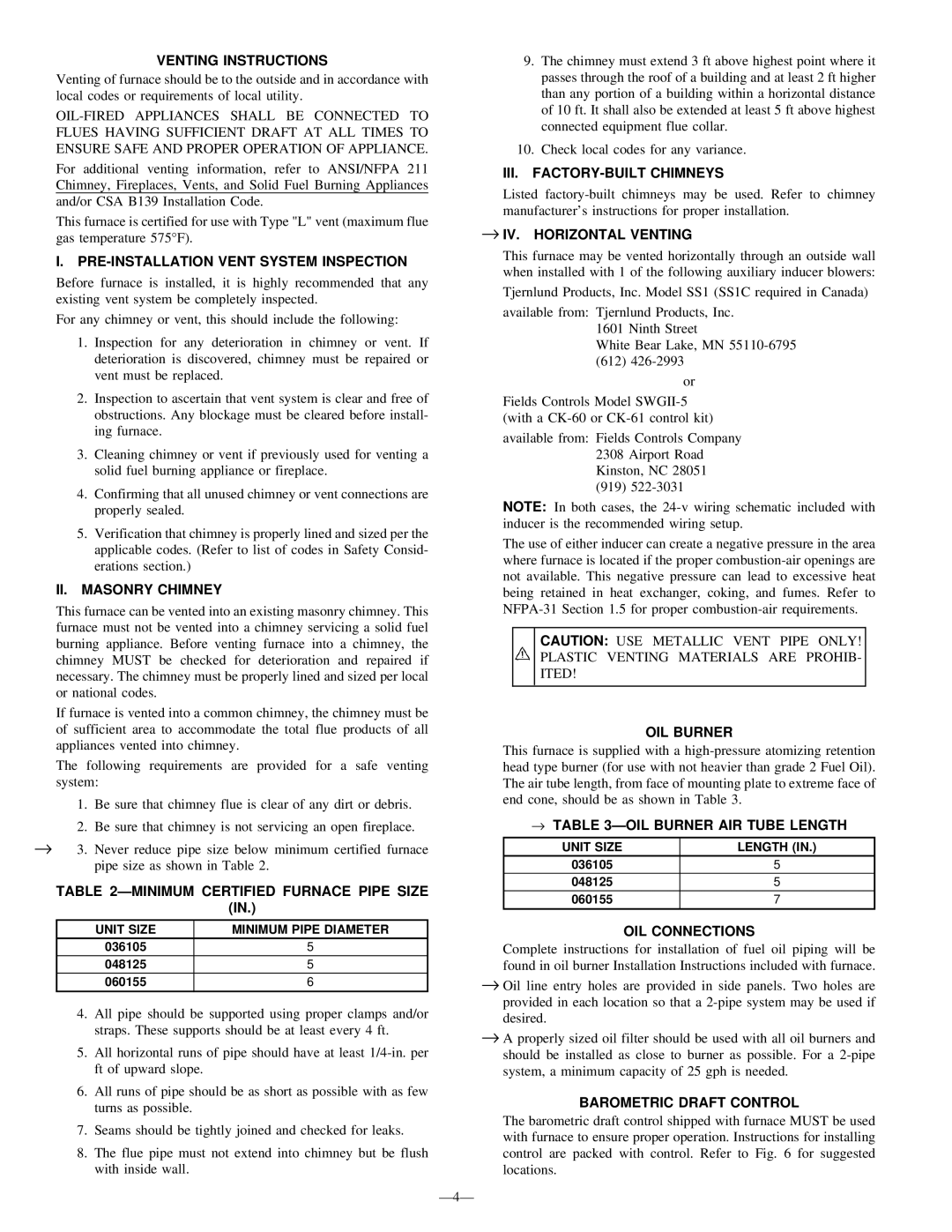VENTING INSTRUCTIONS
Venting of furnace should be to the outside and in accordance with local codes or requirements of local utility.
OIL-FIRED APPLIANCES SHALL BE CONNECTED TO FLUES HAVING SUFFICIENT DRAFT AT ALL TIMES TO ENSURE SAFE AND PROPER OPERATION OF APPLIANCE.
For additional venting information, refer to ANSI/NFPA 211 Chimney, Fireplaces, Vents, and Solid Fuel Burning Appliances and/or CSA B139 Installation Code.
This furnace is certified for use with Type "L" vent (maximum flue gas temperature 575°F).
I.PRE-INSTALLATION VENT SYSTEM INSPECTION
Before furnace is installed, it is highly recommended that any existing vent system be completely inspected.
For any chimney or vent, this should include the following:
1.Inspection for any deterioration in chimney or vent. If deterioration is discovered, chimney must be repaired or vent must be replaced.
2.Inspection to ascertain that vent system is clear and free of obstructions. Any blockage must be cleared before install- ing furnace.
3.Cleaning chimney or vent if previously used for venting a solid fuel burning appliance or fireplace.
4.Confirming that all unused chimney or vent connections are properly sealed.
5.Verification that chimney is properly lined and sized per the applicable codes. (Refer to list of codes in Safety Consid- erations section.)
II.MASONRY CHIMNEY
This furnace can be vented into an existing masonry chimney. This furnace must not be vented into a chimney servicing a solid fuel burning appliance. Before venting furnace into a chimney, the chimney MUST be checked for deterioration and repaired if necessary. The chimney must be properly lined and sized per local or national codes.
If furnace is vented into a common chimney, the chimney must be of sufficient area to accommodate the total flue products of all appliances vented into chimney.
The following requirements are provided for a safe venting system:
1.Be sure that chimney flue is clear of any dirt or debris.
2.Be sure that chimney is not servicing an open fireplace.
→3. Never reduce pipe size below minimum certified furnace pipe size as shown in Table 2.
TABLE 2ÐMINIMUM CERTIFIED FURNACE PIPE SIZE
(IN.)
UNIT SIZE | MINIMUM PIPE DIAMETER |
036105 | 5 |
048125 | 5 |
060155 | 6 |
4.All pipe should be supported using proper clamps and/or straps. These supports should be at least every 4 ft.
5.All horizontal runs of pipe should have at least 1/4-in. per ft of upward slope.
6.All runs of pipe should be as short as possible with as few turns as possible.
7.Seams should be tightly joined and checked for leaks.
8.The flue pipe must not extend into chimney but be flush with inside wall.
9.The chimney must extend 3 ft above highest point where it passes through the roof of a building and at least 2 ft higher than any portion of a building within a horizontal distance of 10 ft. It shall also be extended at least 5 ft above highest connected equipment flue collar.
10.Check local codes for any variance.
III. FACTORY-BUILT CHIMNEYS
Listed factory-built chimneys may be used. Refer to chimney manufacturer's instructions for proper installation.
→IV. HORIZONTAL VENTING
This furnace may be vented horizontally through an outside wall when installed with 1 of the following auxiliary inducer blowers:
Tjernlund Products, Inc. Model SS1 (SS1C required in Canada)
available from: Tjernlund Products, Inc. 1601 Ninth Street
White Bear Lake, MN 55110-6795
(612)426-2993
or
Fields Controls Model SWGII-5 (with a CK-60 or CK-61 control kit)
available from: Fields Controls Company 2308 Airport Road Kinston, NC 28051 (919) 522-3031
NOTE: In both cases, the 24-v wiring schematic included with inducer is the recommended wiring setup.
The use of either inducer can create a negative pressure in the area where furnace is located if the proper combustion-air openings are not available. This negative pressure can lead to excessive heat being retained in heat exchanger, coking, and fumes. Refer to NFPA-31 Section 1.5 for proper combustion-air requirements.
CAUTION: USE METALLIC VENT PIPE ONLY!
PLASTIC VENTING MATERIALS ARE PROHIB-
ITED!
OIL BURNER
This furnace is supplied with a high-pressure atomizing retention head type burner (for use with not heavier than grade 2 Fuel Oil). The air tube length, from face of mounting plate to extreme face of end cone, should be as shown in Table 3.
→TABLE 3ÐOIL BURNER AIR TUBE LENGTH
UNIT SIZE | LENGTH (IN.) |
036105 | 5 |
048125 | 5 |
060155 | 7 |
OIL CONNECTIONS
Complete instructions for installation of fuel oil piping will be found in oil burner Installation Instructions included with furnace.
→Oil line entry holes are provided in side panels. Two holes are provided in each location so that a 2-pipe system may be used if desired.
→A properly sized oil filter should be used with all oil burners and should be installed as close to burner as possible. For a 2-pipe system, a minimum capacity of 25 gph is needed.
BAROMETRIC DRAFT CONTROL
The barometric draft control shipped with furnace MUST be used with furnace to ensure proper operation. Instructions for installing control are packed with control. Refer to Fig. 6 for suggested locations.
Ð4Ð

